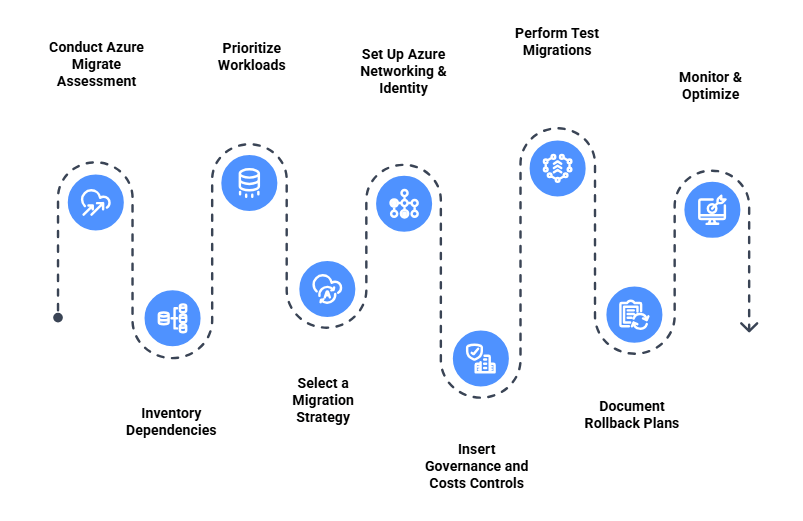- April 17, 2024
Moving from On-Premises to Azure: A Seamless Cloud Migration Journey
On-premises to Azure migration is becoming a strategic imperative for modern enterprises. The reasons why over 95 percent of Fortune 500 companies are already on Microsoft Azure are pretty evident.
In today’s cloud-first environment, Azure provides a secure, scalable, and cost-effective platform that propels enterprises toward modernization and innovation for growth.
Flexera’s 2023 State of the Cloud report states that 82 percent of enterprises already have a multi-cloud strategy, and Azure is high up on the list.
With investments surpassing $1 billion in security, more than 200 cloud services, along with strong hybrid features, Azure is no longer just an option, it is at the very heart of modern digital transformation.
If you are trying to determine how to migrate on-premises servers to Azure, then this Azure expert guide takes you through every step to help you plan and implement a secure and high-performance cloud migration.
Why Migrate to Azure? Top 5 Business Drivers

Cost Optimization: This kind of pay-as-you-go Azure functionality turns infrastructure into save CapEx, capex and provides predictability for OpEx started aftersa long. IDC also claims that organizations save between 30% and 50% simply by shifting workloads to the cloud; further savings are brought about by Azure Reserved Instances and Hybrid Use Benefits.
Enhanced Security: Microsoft invests over $1 billion per year in cybersecurity. Azure comes equipped with security models, compliance certifications, and built-in tools such as Sentinel and Defender for Cloud. This means that over 90 compliance offers are readily used for data security.
High Availability & Disaster Recovery: Geo-redundancy, or automated backup, in Azure form makes it easier for business continuity to adopt a cost-effective form. With these features such as Availability Zones and Site Recovery, business continuity during serious incidents becomes minimized without generating suboptimal downtime.
Scalability on Demand: Azure resource allocation can be adjusted based on fluctuating demand-in real time, up or down, as workload needs differ. Further adaptability comes from other auto-scaling and container services.
Accelerate Innovation: Azure may create over 200 solutions, from AI to machine learning, IoT, and DevOps, and provide businesses with the ability to speed up from conception to production by 5x compared to traditional environments. CI/CD integration of development teams has been simplified by Azure DevOps and GitHub Actions.
Pre-Migration Considerations: What to Know Before You Start
Before getting started with migration, evaluate what you have:
Workload inventory: What servers, databases and applications are running on premises?
Dependencies: Are there apps or systems tightly coupled?
Compliance: Are there HIPAA, GDPR, or industry-specific requirements?
Performance expectations: What are your SLAs for speed, uptime, and recovery?
Migration goals: Are you rehosting, refactoring, or rebuilding systems?
Gartner notes that “90% of organizations that lack a cloud migration plan will suffer service disruptions through 2025.”
The migration assessment of Azure shows its utility in affording good visibility of your existing environment while offering recommendations for your planned moving instances. You can assess readiness in terms of planning its dependencies with minimal business impact.
Questions to Ask Yourself Before Migrating to Azure
- Which workloads are critical, and which may be retired or refreshed?
- Can we go cloud-native, or do we need to have hybrid support?
- What is our readiness for cloud today?
- Do we have internal capabilities, or do we need a partner for this transition?
- What does success look like after migration?
- Long-term maintenance and support planning?
These questions assist in shaping your Azure cloud migration strategy and help in avoiding later surprises.
Step-by-Step Framework for On-Premises to Azure Migration

Assessment: Tools such as Azure Migrate should be utilized to discover the on-premises environment; it can assist with identifying dependencies. Azure’s assessment phase forms a really accurate picture, costs, compatibility, and sizing.
Planning: Define your goals, select workloads for migration, and decide on rehosting (lift-and-shift), refactoring (modernizing components), or rearchitecting (rebuilding for cloud-native). Use this phase to set budgets, timelines, and KPIs.
Preparation: Address network configurations, backup requirements, and compliance needs. Establish governance, policies, and tagging strategies by which to hold oneself accounted.
Migration: Workload transfer using Azure Migrate, Site Recovery, and totally third-party tools. Do not begin with the mission-critical systems first. Azure Database Migration Service will give a seamless transfer of DB data.
Optimization: Browse through the tuning process of your infrastructure post-migration for performance, security, and cost, using Azure Monitor, Advisor, and Cost Management. Implement autoscaling, review performance metrics, and optimize VM sizes.
Security & Compliance: Introduce strategies for governance, DDoS security, backup and disaster recovery. Use Azure Policy and Blueprints to implement configurations.
Step-by-step best practices in Azure migration are reflected in this structured model of operations that can mitigate risks in the process of transition.
On-Premises to Azure Migration Checklist

Moving workloads is merely a little part of the complete Azure migration, and here is a checklist of steps for original planning and execution.
Conduct Azure Migrate Assessment: Get an inventory of all on-premises servers, databases, and applications. Identify dependencies and compatibility risks.
Define Clear Migration Goals: Set up objectives, be it gain savings, modernization, scaling up, or better availability.
Inventory Dependencies: You must define application interdependencies to avoid anything breaking during the transition.
Prioritize Workloads: Sort workloads based on their complexity and their business impact and start the least risky.
Select a Migration Strategy: Choose to rehost (lift and shift), refactor, re-architect, or replace.
Set Up Azure Networking & Identity: Creation of VNets, subnets, NSGs, and incorporation into Azure Active Directory.
Insert Governance and Costs Controls: Efficiency of managing cloud expenditure with tagging, Azure Policy, and budget alerts.
Perform Test Migrations: Conduct practice trials to test performance, assurance, and functionality.
Document Rollback Plans: Always prepare for recovery with a clearly defined fallback strategy.
Monitor & Optimize: Make use of the attributes of Azure Monitor and Azure Cost Management for continuous performance tuning and oversight.
Migration Tools You’ll Need for Azure
Azure Migrate offers baseline tools for assessment and migration.
- Azure Site Recovery can be used for disaster recovery or lift-and-shift migrations.
- Azure Backup protects critical data.
- Azure Cost Management for estimating and tracking spend
- Azure Monitor and Log Analytics can be used for operational visibility
- Azure Arc – Management of hybrid resources
- Azure Blueprints – Governance template
- Third-party tools – Cloud Endure, and Carbonite for some niche use cases.
These tools ease Azure migration and reduce manual effort. Microsoft itself provides a set of reference architectures and migration playbooks.
Best Practices for a Successful Azure Migration
- Start small-the very first experiment to test your plan should be low risk-high reward workloads.
- Fully automate, if possible, use Azure Resource Manager templates, Bicep and PowerShell.
- Involve stakeholders early-gather commitments from both business and technical leads.
- Test appropriately, validate every phase before proceeding into production.
- Implement governance from Day 1. Avoid cost and compliance issues.
- Keep track continuously. Use Azure Monitor for health and performance monitoring.
- Always have a rollback plan in case some failure occurs.
According to IDC, organizations that conducted structured cloud migrations experienced a 47% increase in IT productivity and reduced downtime by 30%. These best practices have been established for smooth transitions and good returns.
Why Choose HexaCorp for On-Premises to Azure Migration?
At HexaCorp, we help organizations build future-proof Azure environments in healthcare, finance, and manufacturing. We have hands-on experience, strategic insight, and expertise in automation to each project.
Our Azure managed service offerings span initial assessment through post-migration optimization. Small and medium businesses or large enterprises will have an Azure migration that is secure and scalable according to your specific requirements. Our teams rely on industry-best tools and follow Microsoft-approved methodologies in all instances.
This ensures that your cloud environment is in tune with where your business really wants to go. Whether it’s a single app or an entire data center – HexaCorp makes it easier to minimize risk, manage costs and scale faster.
Ready to Migrate? Let’s Talk.
Still confused on how to migrate on-premises servers to Azure? Well, don’t worry because we have the best solution for you. Book a free consultation with our Azure experts and get the best blueprint suited to your business.
Here are our services:
- Conducting readiness assessments
- Performing accurate cost estimations
- Developing a phased migration plan
- Implementing and optimizing your cloud setup
Conclusion: Unlock the Full Potential of Azure with a Trusted Partner
A perfectly staged Azure migration facility delivery is beneficial to an organization beyond cost savings. It also provides agility, security, and growth options.
The cloud is no longer the next thing; it is now reality. Given the right tools, strategies, and partners, it is smooth, secure, and transformational for you to move on-prem into Azure.
HexaCorp can do the jump for you! Bar the complete potential of Microsoft Azure with a group that knows how it has done in the past – and how it should be done differently.
Happy Learning!!
FAQ:
What is on-premises to cloud migration?
On-premises to cloud migration refers to the transfer of applications, data, and workloads from local servers to a cloud platform such as Microsoft Azure for the greater good of scaling, flexibility, and cost efficiency.
How to replicate on premise VM to Azure?
There are tools available-Hybrid capabilities with Azure Migrate and Azure Site Recovery-to enable a smooth and secure transfer of your machine unto Azure.
What is the first step in migrating from on-premises to Azure?
The first step towards Azure migration requires evaluating the current environment via Azure migration assessment to determine a suitable migration strategy.
How long does an on-premises to Azure migration typically take?
An Azure migration might take some weeks to a couple of months depending on the number of workloads, their complexity, and the readiness of the migration team.
What tools are recommended for Azure migration?
Recommended tools comprise Azure Migrate, Azure Site Recovery, Azure Backup, Azure Cost Management, and Azure Monitor for an all-inclusive migration experience.
Is there downtime during the migration to Azure?
Definitely, some downtime events will arise in the course of Azure migration, but mostly such events will depend on the plan put in place and the replication tools leveraged during the process, for example Azure Site Recovery.
How do I estimate costs for an Azure migration?
Cost estimations for Azure migration can be performed using the Azure Pricing Calculator and the inbuilt cost estimation features of Azure Migrate.
What are the biggest risks in Azure migration?
Major risks include data loss, unexpected downtime, application compatibility issues, lack of adequate planning and testing.
Do I need managed services for my Azure migration?
While not a hard requirement, applying managed services during Azure migration will significantly cut risks for the client and within the services during implementation and any fine-tuning after migration.




